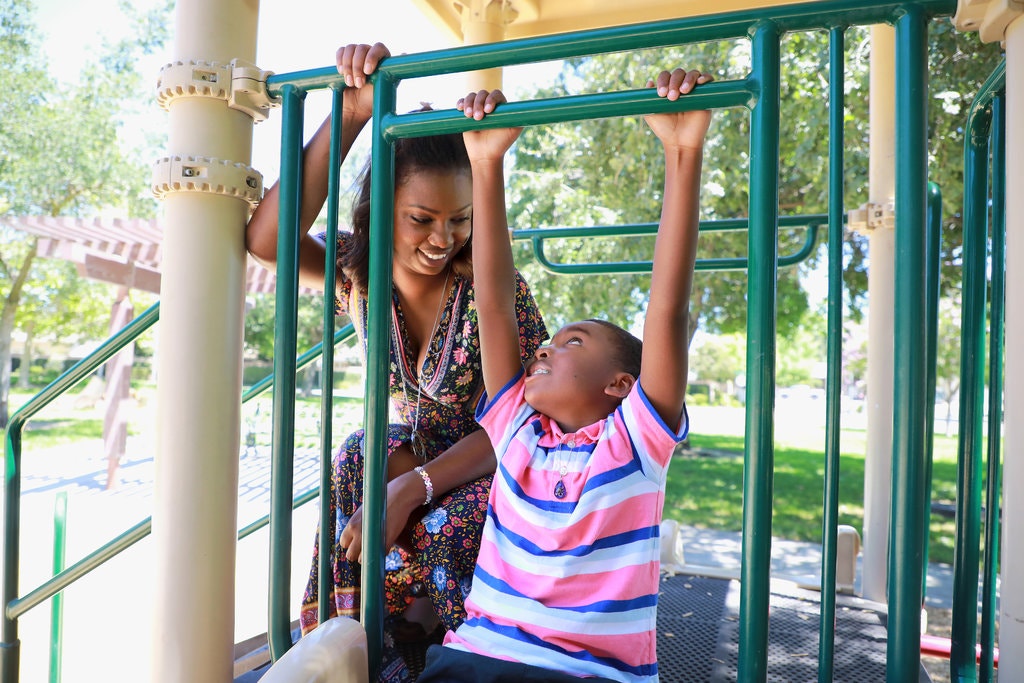BLACK FAMILIES WERE HIT HARD BY THE PANDEMIC. THE EFFECTS ON CHILDREN MAY BE LASTING.
Setbacks in household wealth and the toxic stress of racism can have long-term effects, experts said.

By Kelly Glass
Kourtney McGowan was furloughed in March, when the preschool she worked at closed during the coronavirus shutdown. The relationship with her longtime partner quickly crumbled under the pressure. They broke up “due to mental health issues” that she said started to appear with both of them being stressed out and inside all day.
McGowan said she waited almost a month to receive unemployment benefits in California, and the financial setback was a huge blow. “Every day I’m trying to play catch-up,” she said.
As McGowan’s workplace prepared to reopen, she met another obstacle many parents are faced with as states loosen restrictions: child care. She called the program her 8-year-old son previously attended, but they had no plans to reopen.
Hoping to return to work, McGowan asked her boss for a more flexible schedule. “I can’t have my son in my office for eight hours every day,” she said. Her boss said no. She had no plan for reliable child care, and her job replaced her.
More than 36 million Americans are unemployed in the aftermath of nationwide pandemic shutdowns. McGowan is one of the 1.7 million Black women who was working pre-coronavirus and wants to continue working, but is left without a job.
According to research from the Center on Poverty and Social Policy at Columbia University, working-age adults, children and Black Americans will fall below the poverty line at the highest rates as a result of the coronavirus pandemic’s economic effects.
At the intersection of those vulnerable groups are Black children, who are already disproportionately represented in America’s poor. According to data from the American Community Survey and analyzed by the Kids Count Data Center, a nonprofit tracking the well-being of children in the United States, 32 percent of Black children live in poverty, compared with 11 percent of white children and 26 percent of Hispanic or Latino children.
“The Covid-19 public health and economic crisis certainly is hitting deep within the economy, and it’s affecting every single type of American,” said Bradley L. Hardy, associate professor of public administration and policy at American University. Though many families will certainly feel the stress, “We have some real concerns for Black families for a whole range of historical reasons,” he said.
The reasons that are particularly relevant in this moment are the unemployment rate of Black women, the long-term stress of racism on children, and the lack of household wealth that Black families have.
The unemployment rate for Black women continues to increase.
The most recent jobs report revealed a familiar inequity: Black and Hispanic workers are having a harder time finding jobs. Before the pandemic, black households in particular had higher unemployment rates than white households.
Black mothers’ work force participation and earnings are crucial to the economic health of Black children, said Kristen E. Broady, Ph.D., dean of the college of business and professor of economics at Dillard University. The vast majority of Black mothers are the primary breadwinners for their households. They are more than twice as likely as white mothers, and more than 50 percent more likely than Hispanic mothers, to be either the sole providers in a single-parent household or married and bringing in the same amount or more than their partner, according to analysis from the Center for American Progress, a nonpartisan policy institute.
As states open up and workplaces start to bring back employees, the unemployment rate for white men and women and Hispanic men and women is improving, while the unemployment rate for Black women continues to increase.
Even these figures may be understating the unemployment problem for Black women, said Jessica Fulton, the vice president of the Joint Center for Political and Economic Studies, a public policy think tank. “You have to have lost your job and be looking for work,” she said. “If you’re a single mom, for example, and you are not looking for a job because your kids are at home, you don’t get counted.”
“A lot of Black children are in households where there’s just mom working or there are two parents both working in order to make ends meet,” said Fulton. “This is potentially going to impact Black children disproportionately.”
While unemployment is a strong predictor for child poverty, poverty is only one part of the story.

Toxic stressors over time can lead to long-term physical and mental health issues.
Eileen Condon, Ph.D., a nurse practitioner and postdoctoral associate at Yale University School of Nursing, and her colleagues examined the stressors related to the coronavirus pandemic, and how they disproportionately harm disadvantaged and marginalized families.
Poverty, food insecurity and housing insecurity are major sources of pervasive stress, Condon said. When a child experiences toxic stress, their stress response is “essentially always activated.” “Over time, the inflammation and the adrenaline and all of the things that are going on in the body start to wear and tear on all of the different systems,” she explained, “and that is what leads to poor physical and mental health outcomes for children who experience early adversity.”
Vicarious racism, or secondhand exposure to racism that Black children may experience watching or hearing about the killings of George Floyd, Breonna Taylor and Ahmaud Arbery, is also a source of pervasive stress, Condon said.
Hardy said, “We know quite a bit from the child development literature about how these sorts of stressors really impede child development.” While these early stressors predated the Covid-19 crisis, the effects of the pandemic and exposure to the deaths of these Black Americans will exacerbate the potential for toxic stress, he said.
Black children are also being left behind in the education system at all levels. For children from pre-K through high school, both Broady and Hardy said uninterrupted access to the hardware and internet necessary to successfully participate in online learning is another huge concern. According to data from Pew Research Center, even before education went fully digital because of the pandemic, Black and Hispanic students were unevenly affected by the lack of access to high-speed internet services.
“Such infrastructure concerns are very real for Black families, and certainly some of them will be fine, but disproportionately, that’s going to be a major issue,” said Hardy.

Black households have less wealth than White households.
According to Federal Reserve data, Black households typically have one-tenth of the wealth of a typical white household. The lack of wealth of Black households is an issue for Black children, as any unexpected emergency — like a pandemic — can cause food and housing insecurity and stress for children when there is no financial cushion.
It’s also a concern for the future prospects of Black children. For a 2018 study on racial disparities in economic mobility, economists examined longitudinal data from the U.S. Census Bureau of nearly the entire U.S. population from 1989 to 2015, and found that Black children born into poverty were twice as likely as white children to stay there.
Though poverty rates for Hispanic Americans are similar to those of Black Americans, they are almost as likely as white children to move out of poverty as adults. Additionally, the researchers found that Black children born into higher income groups have a harder time staying in those income brackets. The study’s authors were careful to note that their findings suggest neither parental marital status, education level nor children’s difference in ability could explain away this intergenerational mobility gap.
“American public policy has made it very difficult for Black Americans to accumulate and sustain wealth in general,” said Hardy. The Black-white wealth gap has persisted despite increasing numbers of Black women attaining college degrees. Hardy cited America’s well-documented history of segregation, excluding Black Americans from the G.I. Bill and educational attainment, redlining policies that segregated communities and devalued homes in Black neighborhoods, and “plain racial labor market discrimination” as reasons Black families have less wealth to help protect them from the devastating effects of an economic crisis.
“If you put it all together,” Hardy said, “then Black parents are going to have quite a bit less to leave to their children.” The pandemic is exacerbating the existing economic inequalities for Black families and is subsequently worsening the future economic outlook for Black children, despite all best efforts by Black parents like McGowan to work their way up.
The prospects aren’t great for McGowan, whose certifications are in child care, since service sector jobs where Black women are overrepresented have had some of the biggest cuts. Her son, who she said seems unaware of their current financial struggles, is suddenly anxious about death and dying. He’s in counseling, and she’s thinking about going back to college. “We do what we got to do,” she said.
For now, McGowan said she will see what the future holds. “Raising Black boys is hard in itself,” she said. “I’m just trusting God.”



